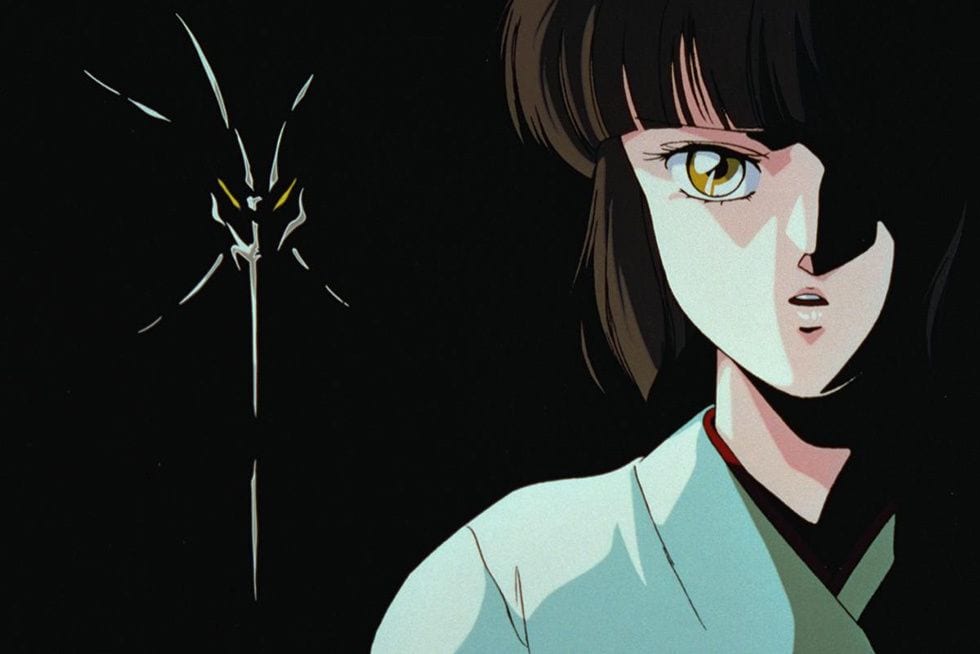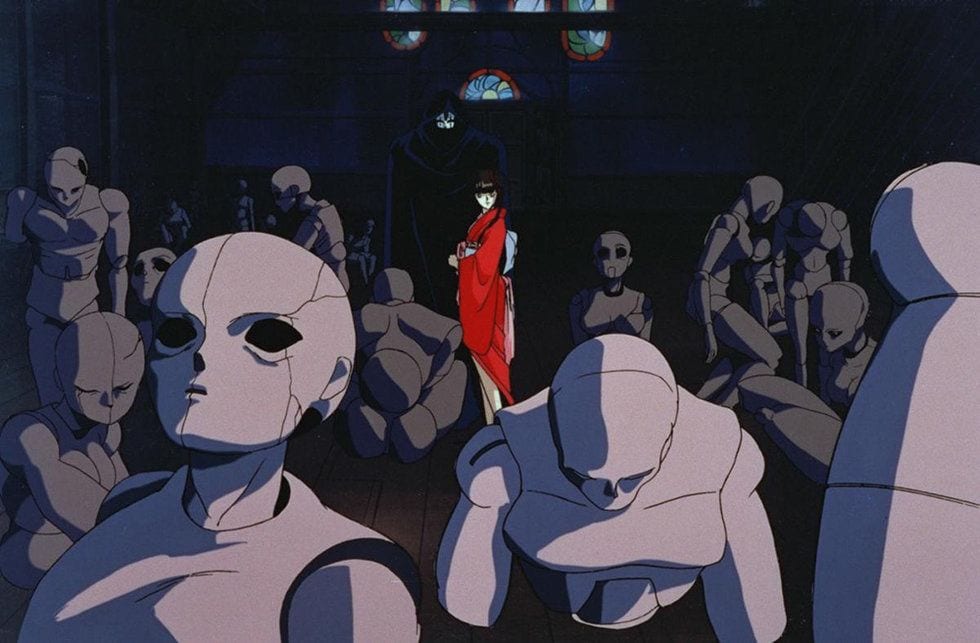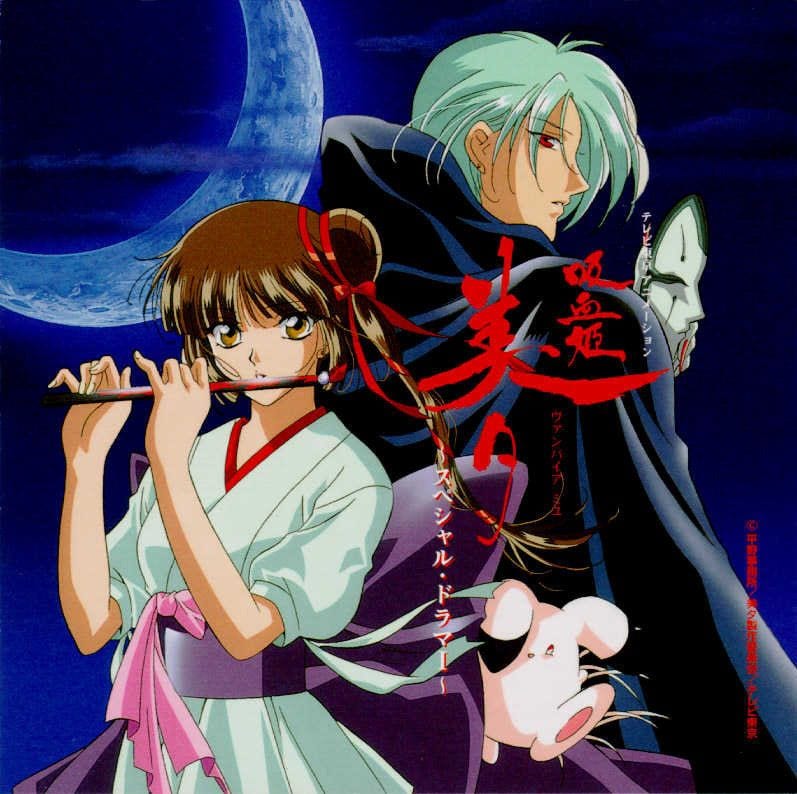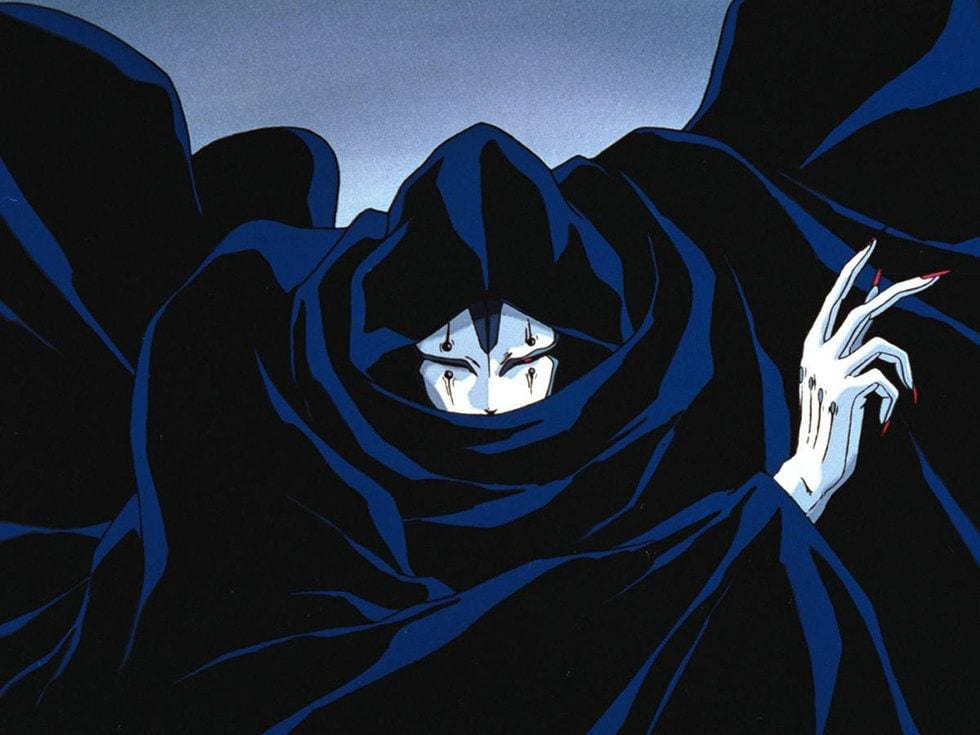The anime horror television series, Vampire Princess Miyu, turns 22 this year. It’s a weird anniversary to note, but appropriate for a series that didn’t get a 10th or 20th-year celebration. Despite being one of the better series to come out of Studio AIC in the ’90s, over two decades later, it seems to be largely forgotten in the US. What was Vampire Princess Miyu? Why did it disappear? Is it worth remembering?
Welcome to Miyu’s Dark Realm
Vampire Princess Miyu is a 26-episode television series that aired on TV Tokyo from 7 October 1997 to 31 March 1998. It was originally a manga series created by manga artist and director Narumi Kakinouchi and her husband, Toshiki Hirano. It aired for ten volumes between 1988 and 2002. Aside from the television series, it produced several spin-off series, as well as a four-episode Original Video Animation (OVA), in 1988.
Kakinouchi and Hirano have both worked in the anime and manga industry for decades in various positions. Kakinouchi is mainly known as a manga artist, with her most popular work being
Vampire Princess Miyu. Hirano directed the Miyu OVA and TV series; he’s probably known best for directing Magic Knight Rayearth.
Vampire Princess Miyu’s opening theme begins with a short narration, introducing the audience to Miyu’s world. It seems appropriate to start there. Cue flute music and gothic drawings:
Shinma are supernatural beings that devour the hearts of men and lead them to ruin. Long ago, they were sealed in the Darkness. However, there are stray Shinma that live secretly in the human world. They lurk in the division between night and day. The Guardian who sends the stray Shinma back to the Darkness is the beautiful vampire, Miyu. No one knows her true form.
The opening directly explains the basic concept of the show to the audience, allowing anyone to jump in at any point. There are supernatural beings in the world that would do harm to humans, and they need to be sent back to where they came. It’s Miyu’s job to send them back. But who is Miyu?
An Introduction to Miyu: A Shinma by Any Other Name
Miyu: Miyu is the series’ titular character and main protagonist. She is forever 13 years old and tasked with returning stray Shinma to the darkness by use of her flame. Ironically, she is half-Shinma herself and must drink human blood to survive. In exchange for their blood, Miyu gives her human victims “eternal happiness”, where they exist in a dream state. This is another irony. Miyu has the power to give away perpetual happiness, while her own destiny causes her immeasurable grief and suffering. Despite the need to feed on human blood, traditional vampire rules don’t apply to her.
Larva: Larva is Miyu’s masked companion, servant, and implied lover. Once an evil Western Shinma, he came to understand Miyu’s fate and now follows her on her mission. He often aids Miyu in fights with his long nails and scythe. When Miyu finally tires of her sad destiny, Larva has vowed to kill her.
Shiina: It was a ’90s anime rule that every show needed an animal mascot and Miyu was no exception. Shiina is a kind of bunny that follows and helps Miyu and Larva. She has a grotesque eye that is covered by one of her ears. It allows her to see that which Larva and Miyu cannot. She’s basically a demonic Ryo-Ohki.
Reiha: Reiha is Miyu’s antagonist for much of the series. She disapproves of Miyu being the Guardian and often interferes where she doesn’t belong. In contrast to Miyu’s flame, Reiha controls ice. She is always accompanied by her talking doll, Matsukaze.
Chisato Inoue: When Miyu enrolls in the local school to get a better lay of the land, she is immediately friended by Chisato. Chisato is friendly, direct, and very enthusiastic. She invites Miyu to join her group of friends, consisting of Yukari Kashima and Hisae Aoki. Yukari is tomboyish and outspoken, while Hisae is more book-smart and reserved.
Miyu exists somewhere between a serialized and anthology series. It is largely a collection of standalone tragedies — stories depicting human suffering that end with a literal or metaphoric death. Most episodes follow a similar format. A new protagonist is introduced. A Shinma comes along and somehow manipulates them, causing them to destroy an important aspect or person in their life. Miyu comes in at the end to send the Shinma back to the darkness. The protagonists usually die at the end. If they’re lucky Miyu feeds on them, insofar as being vampire food is lucky.
The standalone stories are connected by Miyu investigating and ultimately doing battle with the Shinma at the end of each episode. Sometimes Miyu’s classmates have subplots that complement the main plot. Sometimes they’re directly involved with the main plot. Sometimes they’re not involved at all. This gives the show the freedom to tell many different kinds of stories with many different kinds of characters. While the majority of the episodes are isolated, others directly deal with Miyu, Larva, and Reiha’s pasts and conflicts. There’s an overarching plot that takes place subtly in the background for much of the series, which finally comes to a head in the last few episodes.
If the word “vampire” in the title wasn’t enough of a clue, Miyu is heavily rooted in the supernatural horror genre. It’s full of demons, ghosts, occult imagery, lots of blood and death, etc. Despite this, the show never goes for cheap jump scares or ultra-violence. It’s slow and tragic and focuses on the emotional weight of its stories. It’s dramatic horror at its best.
The tone ranges from depressing to really depressing. Within the 26 episodes, there are murders, suicide, and even murder-suicides. There’s something for everyone. Actually, Vampire Princess Miyu is often sad and creepy, but never really conventionally scary.
The music sets much of the tone. Aside from the ending theme (composed by Tamiya Terashima) all of the other music is composed by the incomparable Kenji Kawai. Kawai has composed music for many shows, movies, and video games. The music is excellent and one of the highlights of the series. There are a small handful of upbeat songs played during the battle scenes. However, most of his work here is slow, painful, and beautiful.
Indeed, Vampire Princess Miyu is brutal and fatalistic. Its basic message is that everyone has a predetermined fate and there isn’t a thing anyone can do about it. Humanity is frail and flawed. Free will and choice are illusions people cling to naïvely as coping mechanisms for the reality that’s right in front of them.
This idea is expressed in every episode as characters are exploited by Shinma or destroyed by their own weaknesses. It is perhaps most clearly expressed in the final episode, “The Eternal Sleep”, in which Miyu has been severely injured and has to choose if she wants to live or die. As she contemplates this choice she has visions of her mother, asking her if she wants a red kimono or white kimono. Red kimonos are traditionally worn by prisoners, while white kimonos are traditionally worn by the dead. She’s asking herself if she prefers to die or to continue being a prisoner to her fate. The show is saying that life is a prison and the only other option is death. Neither option is very appealing.
Localization Woes
If Vampire Princess Miyu is really as good as it has been described, how come it isn’t fondly remembered? The reasons fall into two categories. The first is how badly the franchise localization in the US was handled. The second deals with elements of the show that tend to be off-putting to American viewers.
AnimEigo released the four-part OVA series on VHS in 1996. Back in the day, it wasn’t uncommon to see it sitting on the shelves in local video stores. The OVA was short and sweet, but even for the fans that liked it, aside from some comics from Antarctic Press (see samples here at MyComicsShop.com) there wasn’t another official Vampire Princess Miyu release in the US for several years. It’s hard to build a fanbase on such a small amount of content.
In the early 2000s, in the midst of the anime boom, AnimEigo released the OVAs on DVD. Studio Ironcat started publishing the manga (and spin-offs) in English, and Tokyopop released the TV series on VHS and DVD. While it was good to see the rest of Vampire Princess Miyu come to the US, the releases left much to be desired.
The OVA releases from AnimEigo were high quality; however, the rest of the franchise being brought over into the US was something of a mess. Studio Ironcat was a small publishing company without much experience. Translations were awful. The New Vampire Miyu manga series came out around the same time the Star Wars prequels were immensely popular, so they confusedly tried to tie the series into that franchise by giving the books titles like The Shinma Menace and The Western Shinma Strike Back. Ironcat was plagued with legal issues (including charges of embezzlement). Books were often delayed and then printed incorrectly. Ironcat only got to release up to volume 5 of the original manga series before they closed in 2006. Vampire Princess Miyu and all the other Narumi Kakinouchi titles put out by Ironcat would not be released in English again.
The Tokyopop release of the TV series had quality issues as well. The opening theme and ending theme were removed from the middle episodes on the first DVD volume, causing an outcry from fans. English title cards were created by dissolving from the Japanese title cards into poorly designed text over generic video jumpbacks. Subtitle tracks were plagued with errors, misspellings, and weird translations. It was a bad localization. Tokyopop closed its doors in 2011, though it’s been trying to resurrect itself over the last few years.
The early 2000s was a hard time to stand out when countless numbers of titles were released at the same time. The market was becoming overcrowded. Both the TV series and manga release in the US suffered the same fate for identical reasons. Like many other companies during the manga and anime boom, Ironcat and Tokyopop purchased the rights to as many titles as they could, put them out without much quality control as fast as they could, and then ended up having to close when the market simply couldn’t support so many new and sloppily released titles. For those in the US who did get to experience Vampire Princess Miyu, the poorly produced localizations left them disappointed.
Had the TV series been released stateside a little earlier and by a more competent company, perhaps the series would have the same strong fanbase seen today for other ’90s series like Revolutionary Girl Utena or Rurouni Kenshin. Had the same thing happened with the manga, maybe more people would have discovered it and eventually found the TV series. Unfortunately, the localization of Vampire Princess Miyu was both a symptom and a cause of the big anime boom and bust in the early 2000s.
Fun with Determinism
In addition to the mishandled localization, there are some elements to the show itself that seemed to turn off American audiences. To be blunt, the very first episode is horrible. It’s confusing and hard to follow and easily among the series’ worst. Since it never aired on TV in the US, those watching Vampire Princess Miyu needed to pay to buy or rent it. That, combined with the failing of the first episode for western audiences, means that even those that wanted to give the series a chance would move on to something else.
Further, many criticized the series for following the “monster of the week” format. This is an interesting critique, as this is a common trope in both Japanese ( Kamen Rider, Super Sentai, Sailor Moon) and American (The X-Files, Buffy, Fringe) television. Most episodes do follow a similar structure. However, even if it is a bit repetitive, there are a lot of interesting characters, some excellent storytelling, a handful of twists and turns, and even some variance from this formula.
The most defining attributes of the show are its dark tone and themes. A lot of people didn’t care for them. Admittedly, Vampire Princess Miyu is depressing. Ridiculously depressing. It leaves no room for hope or growth. It is story after story of heartbreak and despair. The final episode, in particular, is wholly devastating to the viewer. It ends on a very low note. The series is excellent, but it’s not exactly a fun time.
Wait. What about newer anime series like Berserk and Madoka Magica? They’re super depressing as well, but also wildly popular in the US. While both of those titles deal with dark subject matter and more adult themes, they also leave room for hope and change. Frankly, Bersek‘s theme is the antithesis of Vampire Princess Miyu‘s. Berserk is hopeful. Guts is afforded the chance to change his fate and his future. Maybe even get revenge and be satisfied to some degree. In the Vampire Princess Miyu universe, Guts would have been killed in the first eclipse. Homura, from Madoka Magica, would be forced to relive her ordeal over and over for eternity, lest she kills herself. Fate can’t be changed.
Vampire Princess Miyu isn’t dark just because of its subject matter, however, but also because of the expression of its theme and worldview. People don’t want to drown in so much cynicism for 26 episodes, let alone humor the show’s realism.
If that’s the case, why was the show popular in Japan? It’s difficult to discuss the theme of the show, as well as its reception in the US, without talking a bit about the Japanese suicide epidemic. Suicide has been a major issue in Japan for decades. News stories about its suicide forests and high youth suicide rates are commonplace. Indeed, Japan consistently has one of the highest suicide rates in the developed world.
The reasons for this aren’t clear, though most experts agree it has to do with societal pressures and feelings of alienation brought about by an inherently Japanese need to feel “normal” and accepted by society. To top it off, Japan doesn’t suffer from Christian guilt like much of the Western world. This means suicide isn’t stigmatized. Not only is it tolerated, it’s often considered a noble act.
Looking at Vampire Princess Miyu through this lens, its theme and worldview make a little more sense. The show was created in a culture where choosing death over life can be seen as a viable way out of one’s problems. It’s important to reiterate that Vampire Princess Miyu is a whole franchise in Japan, spanning three decades, and creating several spin-off series over several media formats. While its theme is bleak and dejecting, it resonates with a lot of Japanese people. Staring directly into the void can be cathartic.
US television has certainly embraced darker themes with shows like Game of Thrones and The Walking Dead being prime examples. While definitely glum, both of these shows came out a decade after Vampire Princess Miyu and still, despite their violence and bleak worldview, offer warmer worlds.
Back into the Darkness
There aren’t many legitimate options for those who want to watch the series today. Home video distributor Section 23 re-released the TV series under its Maiden Japan label back in 2013, but it has since gone out of print. It’s currently available on iTunes for $20, but it appears to be the English dub, which is especially flat, uninspired, and should be avoided.
The real tragedy of Vampire Princess Miyu is that one of the more interesting series of the ’90s is out of print and largely reduced to a horror anime footnote. With the recent release of a new manga series in Japan — Vampire Miyu: New Moon — the franchise might have a chance to come out of the shadows once more. Could it resonate with today’s fans who are enamored with series in the idol and isekai genres of anime?
For those that saw it, Vampire Princess Miyu is remembered with melancholy. Fond memories for something sad. Its botched localization and harsh worldview meant Vampire Princess Miyu was destined to be left in the darkness and mostly forgotten. And, unfortunately, if that’s the fate of the series, there’s absolutely nothing that can be done about it.






